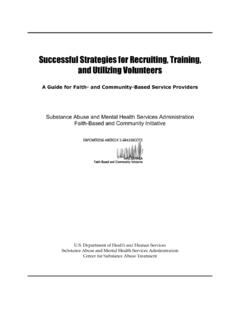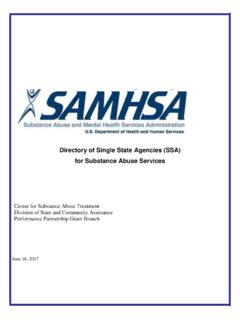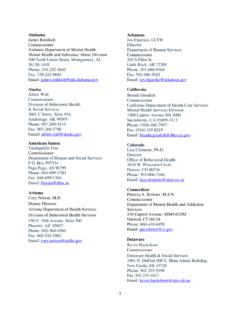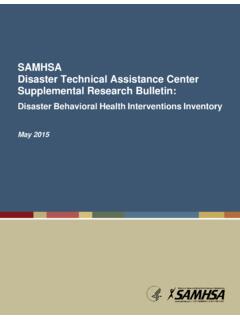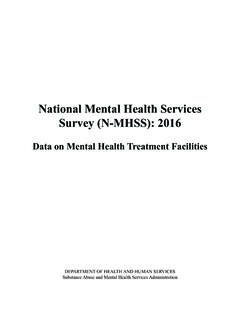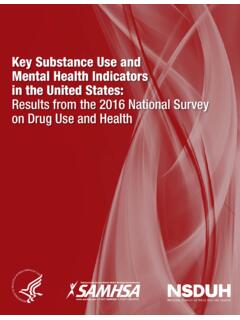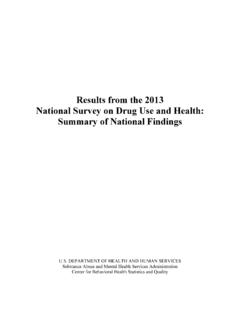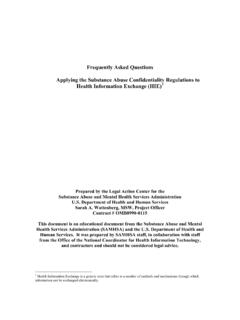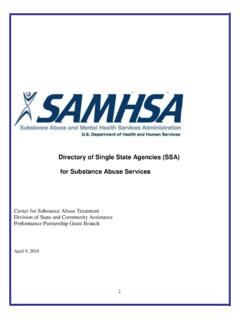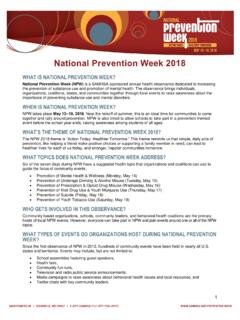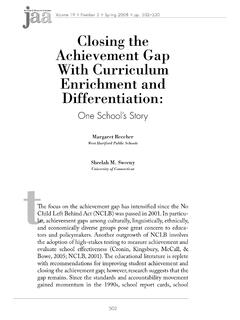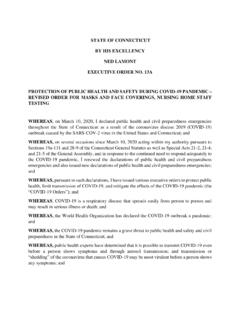Transcription of Issue Brief and Restraint in Behavioral Health Services
1 Promoting Alternatives to the Use of Seclusion and RestraintA National Strategy to Prevent Seclusion and Restraint in Behavioral Health ServicesIssue Brief #1 MARCH 2010 About the Series: Promoting Alternatives to the Use of Seclusion and RestraintThe Substance Abuse and Mental Health Services Administration (SAMHSA) has developed, in collaboration with partners at the Federal, State, and local levels, consumers, and national advocacy organizations, a series of Issue briefs on the use of seclusion and Restraint . The purpose of this series is to provide information on the use of seclusion and Restraint throughout the country, their impact at the individual/family, program, and system levels, and efforts to prevent their use in mental Health and other service settings, including schools.
2 Additional Issue briefs in the series may be found at the United States each year, it is estimated that 50 to 150 individuals die as a result of seclusion and Restraint practices in mental Health inpatient residential facilities and many others are injured or traumatized by these events (Weiss et al., 1998). In fact, seclusion and Restraint are dangerous and traumatic not only to the individuals subjected to these practices, but also for the staff implementing them. The Government Accountability Office (GAO; 1999a) noted that seclusion and Restraint continue to be used in these facilities despite the psychological and physical harm they cause to consumers.
3 The Cochrane Collaboration, which provides reviews of the evidence of Health care practices, noted of seclusion and Restraint : few other forms of treatment which are applied to patients with various psychiatric diagnoses are so lacking in basic information about their proper use and efficacy (Sailas and Fenton, 2000, ). In addition, surprisingly, there is no uniform method for tracking these injuries or deaths within States or across the country. The GAO (1999a) highlighted insufficient monitoring and reporting of the use of seclusion and Restraint and inconsistent standards for using these practices and reporting their Substance Abuse Mental Health Services Administration (SAMHSA) in the Department of Health and Human Services and the National Association of State Mental Health Program Directors (NASMHPD) have emphasized that the use of seclusion and Restraint is a result of treatment failure (Curie, 2003; NASMHPD, 2001).
4 SAMHSA further notes that with leadership, policy, and programmatic change, the use of seclusion and Restraint can be prevented and in some facilities has been eliminated. This Issue Brief is the first in a series on the use of seclusion and Restraint with children, youth, and adults with mental Health problems. The Brief provides an overview of the history and context of a national focus on reducing or preventing the use of seclusion and Restraint within mental Health and addictions inpatient treatment settings. DEPARTMENT OF Health AND HUMAN SERVICESS ubstance Abuse and Mental Health Services and Literature DefinitionsThe Centers for Medicare and Medicaid Services (CMS), in their issuance of a final rule related to consumers rights in the hospital setting defined seclusion and Restraint as follows: Restraint is any manual method, physical or mechanical device, material, or equipment that immobilizes or reduces the ability of a person to move his or her arms, legs, body, or head freely.
5 42 (e)(1)(i)(A). See also 42 is the involuntary confinement of a person alone in a room or area from which the person is physically prevented from leaving. 42 (e)(1)(ii); See also 42 definitions above relate to Restraint , which should be distinguished from Restraint used for medical purposes as part of medical treatment or a procedure, and from postural supports or orthopedic devices used to improve a person s mobility and independent functioning rather than to restrict movement. Clarity around the definitions will aid in this the Research ShowsFor many years, numerous misconceptions have supported the use of seclusion and restraints in mental Health inpatient and outpatient facilities, addictions treatment centers and schools, etc.
6 Although seclusion and Restraint were long thought to create a safer and more secure environment for consumers and staff, research contradicts this. Studies have shown that psychological harm, physical injuries, and death can result from the use of seclusion and Restraint to both the individual subjected to and staff applying these techniques (NASMHPD, 2009; Sailas & Fenton, 2000; Weiss et al., 1998). In fact, injury rates to staff in mental Health settings where seclusion and Restraint are used have been found to be higher than injuries sustained by workers in high-risk industries such as lumber, construction, and mining (Weiss et al.)
7 , 1998; Love & Hunter, 1996). In addition, the use of seclusion and Restraint has often been perceived as therapeutic to consumers. This misconception has been challenged and refuted (Mohr & Anderson, 2001; NASMHPD, 2009). Increasing research has identified the role of trauma in mental and addiction disorders. Research into trauma1 and trauma-informed care2 identify common themes about the impact of trauma and how traumatic life experiences can impede an individual s ability to manage his or her own behaviors or engage in appropriate behaviors in the community (Fallot & Harris, 2002; Hodas, 2004; van der Kolk, 2007).
8 Subsequently, trauma-informed care has emerged as an approach to care that prevents the re-traumatizing of these individuals. Studies suggest that restraints and seclusion can be harmful and is often re-traumatizing for an individual who has suffered previous trauma (NASMHPD, 2009). Further, there is a common misconception that seclusion and Restraint are used only when absolutely necessary as crisis response techniques. In fact, seclusion and Restraint are most commonly used to address loud, disruptive, noncompliant behavior and generally originate from a power struggle between consumer and staff.
9 The decision to apply seclusion or Restraint techniques is often arbitrary, idiosyncratic, and generally avoidable (Haimowitz, Urff, & Huckshorn, 2006; NASMHPD, 2003; SAMHSA, 2003). Moreover, some studies indicate that seclusion and Restraint use leads to an increase in the behaviors that staff members are attempting to control or eliminate (Jones & Timbers, 2002; Magee & Ellis, 2001; Natta, Holmbeck, Kupst, Pines & Schulman, 1990).Conversely, it is important to note that programs that have reduced or eliminated seclusion and Restraint have realized a number of positive outcomes including reduced youth and staff injuries, reduced staff turnover, higher staff satisfaction, reduced lengths of stay, sustained success in the community after discharge, and significant cost savings (LeBel & Goldstein, 2005; LeBel, in press).
10 Impetus for ChangeIn 1998, the hartford Courant published a Pulitzer Prize-winning expos on the use of seclusion and Restraint in inpatient treatment facilities (Weiss et al., 1998). This series highlighted stories of injuries and deaths that occurred in these settings as well as some of the contributing factors, such as lack of training and inadequate staffing patterns. The influential series of articles served as a catalyst for a sequence of events focused on addressing this Issue . In 1999, the GAO began an investigation on consumer injuries, trauma, and deaths in inpatient treatment facilities.
